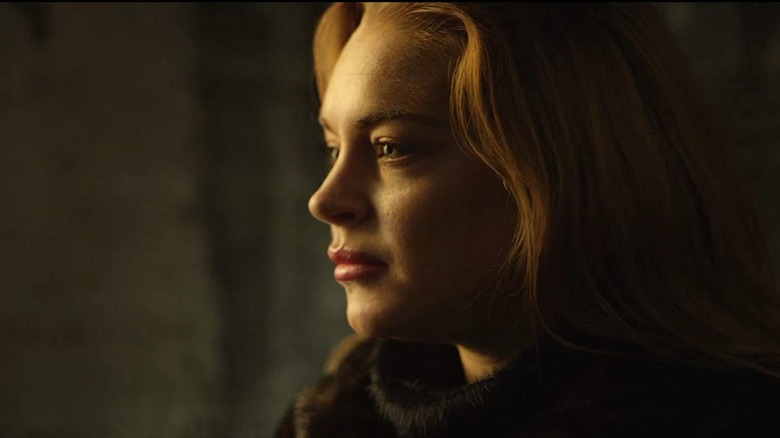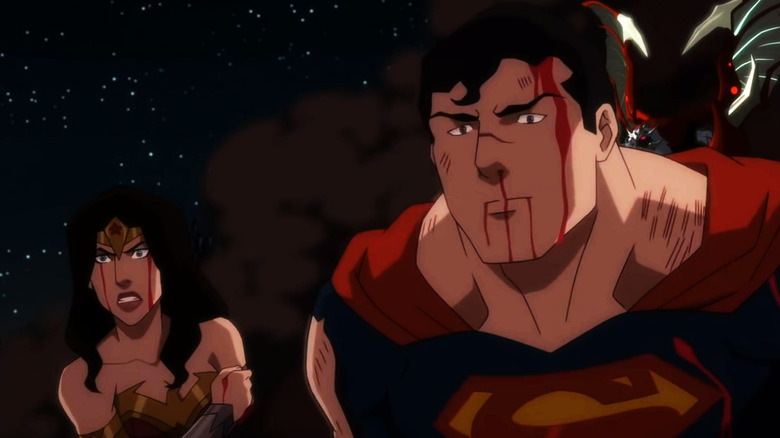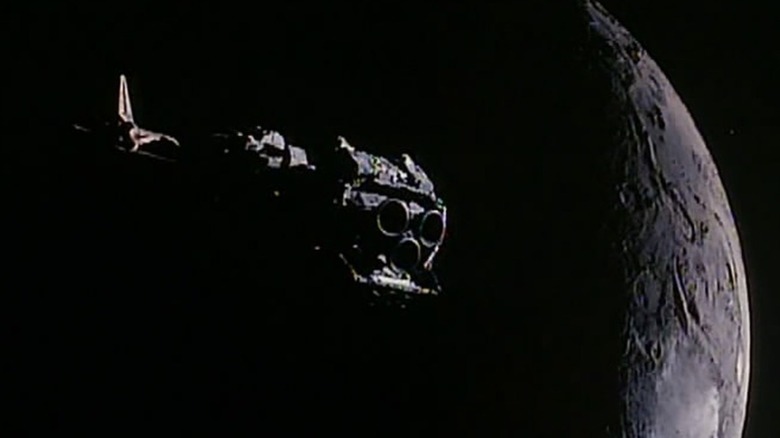What These Movies Predicted About 2022
The year 2022 is here, and the verdict is in. What can we expect? It's going to be another apocalyptic wasteland! At least according to the movies. Plus, there will be a smattering of alien invasions, time travel, werewolves, vampires, purges, and cannibalistic corporations ... so there's that. Predicting the future is tough stuff and filmmakers tend to expect the worst. It's rare you see a movie about a future with rainbows and sunshine — more like nuclear annihilation and armageddon-inducing asteroids.
After the past few years, you may not feel like blaming filmmakers for their foreboding forecasts, but even the first global pandemic in more than a century can't compete with what these cinematic Nostradamus' predicted about 2022. What were their prognostications? It's so wild, crazy, surreal, and scary that we're just glad we don't have to live in these filmmakers' imaginations, and hopefully not in the futures they predicted either. What can we (not) look forward to this year? Here are what these movies predicted about 2022!
Geostorm
You've heard of a perfect storm, but what about a ... "Geostorm?" The 2017 would-be blockbuster was the big-screen directorial debut of Dean Devlin, who collaborated as producer and co-writer with director Roland Emmerich for years on disaster pics like "Independence Day" and "Godzilla (1998)" — and on the box office disaster, "Independence Day: Resurgence." Burn! Anyway, Devlin must have figured "how hard can this be?" and tried his hand at directing disaster with "Geostorm." The result was, well, a disaster. The critical and audience scores are comparable to Minnesota's weather in the winter, while the movie made a grand total of $33 million in the U.S. (less than "ID4" made in three days 21 years earlier), though international audiences saved it from utter annihilation.
Speaking of "utter annihilation," the movie predicts a future in which satellites control the weather. What can go wrong, right? Well, when the satellites go kamikaze on the Earth, it's up to Gerard Butler (well, the superhero scientist he plays) to stop them. What makes these storms a "Geostorm?" We guess because they're attacking the entire planet? The big question is: Can this really happen? Smithsonian Magazine probed the experts and determined: Not really. Turns out the atmosphere isn't a thing, but lots of interconnected things, so controlling it is thankfully make-believe. Though that didn't stop the U.S. government from trying during the Cold War in an effort beautifully called "Project Popeye." Why can't Devlin make that movie?
Soylent Green
Fun party game: Serve your guests something green and call it "Soylent Green." If they get it, you'll know they're the real deal (though don't be surprised if they never eat at your house again). The most famous apocalyptic future pic for the man who played Moses is definitely "Planet of the Apes"; "Soylent Green" is the second. In that 1973 thriller, Charlton Heston stars as a dystopian detective investigating the devious Soylent Corporation after the murder of an executive.
The world has been ravaged by overpopulation and climate catastrophe, leading to massive food shortages. The Soylent Corporation offers the solution with the titular "Soylent Green," a green cracker-like food which isn't very tasty, but packs plenty of nutrients — so, basically something Gwyneth Paltrow would eat. Lots of dystopian detective work goes down (in a movie that came out nine years before "Blade Runner") but, long story short, Heston's character discovers that Soylent Green is ... people!
Overpopulation has been in vogue since Thomas Malthus predicted impending doom in the 1800s, with global development expert Heather Alberro recently saying we're consuming the resources of 1.6 Earths per day. To paraphrase G.K. Chesterton: Ask people who talk about the surplus population if they're part of the surplus. Anyway, we doubt eating humans will feed the growing population as "Soylent Green" predicts. More likely it'll be meatless meats, with the plant-based vegan meats industry alone growing to $7 billion in 2020.
Alien Intruder
We have to say, for a movie that should rightfully be called "Deadly Sex Slave in Space," "Alien Intruder" is probably the most milquetoast title we can imagine. Like, were they worried an on-the-nose title like that would ruin their credibility? Anyway, the 1993 B-movie is basically, well, about a deadly sex slave in space. Lando Calrissian himself, Billy Dee Williams, plays a commander who leads a group of convicts into space to investigate a lost ship in exchange for having their sentences commuted. Of course, the final frontier can get kinda lonely, so the crew is allowed to use a virtual reality program to fulfill their sexual desires.
However, a rogue VR program known as Ariel (played by former model turned actress Tracy Scoggins) kills the other VR females, seduces the men, and forces them to turn against each other in real life. So it's basically "Alien," "Total Recall," and "10," where the xenomorph is replaced by a Sports Illustrated cover girl. "Cyber Brothels" are on the rise (pun intended), but so far the VR sexbots haven't shown sentience, or at least not enough to convince people to kill each other. But if we've learned one thing from movies, it's to never trust artificial intelligence.
The Purge
After making a name for itself (plus a ton of money) with the "Paranormal Activity" franchise, Blumhouse Productions dipped its toes into social commentary with "The Purge" in 2013. The film made $91 million worldwide on a $3 million budget, proving that while crime doesn't pay, a movie about it does. "The Purge" struck a nerve with audiences who were fascinated by its chilling premise: Every year there is a 12-hour time period known as "the purge" in which any and all crime is legal. So if you've always wanted to jaywalk, the purge is your time to let your freak flag fly!
However, a clever premise is nothing without a plot, so "The Purge" focuses on a wealthy family whose home is under assault for holding the target of a crime syndicate. While "The Purge" predicts a lawless society (though if no crimes are against the law, is society really lawless?), both violent and property crime rates in the United States have actually been trending downward for the past three decades. However, in 2020 the U.S. did see a 3% uptick, especially in big cities like Chicago and New York City.
No Escape
Based on its Rotten Tomatoes scores, the people who truly had no escape were the ones watching it in theaters in 1994. We kid, we kid ... but not really. "No Escape" is pretty terrible. Directed by Martin Campbell before "Goldeneye," "No Escape" was one of Ray Liotta's several attempts to parlay his success in "Field of Dreams" and "Goodfellas" into an A-list, above-the-title movie career. With $17 million, it did a little bit worse than his other 1994 bomb, "Corrina, Corrina," but better than his 1997 A-list career killer, "Turbulence."
Adapted from the novel "The Penal Colony" by Richard Herely, the film features Liotta playing an ex-Marine convicted of killing his commanding officer and sent to an inescapable (hence the title) corporate-run jungle prison which is overrun by an intertribal war between two rival prison factions. How realistic is it? The U.S. has the largest private prison system in the world, with more than 115,000 inmates as of 2019. However, that number is less than 10% of the total prison population, with 92% of inmates incarcerated in public prisons and jails, and has actually declined 16% since its peak in 2012. While we can't say for certain there aren't corporate-owned jungle prisons where inmates are forced to fight in intertribal war, you should probably stay on the safe side and pay that overdue parking ticket.
Among The Shadows
What "The Godfather" was for Marlon Brando, "Pulp Fiction" was for John Travolta, and "Iron Man" was for Robert Downey Jr., "Among The Shadows" was supposed to be for Lindsay Lohan. So naturally, for her big comeback Lohan chose a C-level "Underworld" ripoff so irrelevant, it didn't even garner a Tomatometer score, while its audience score is dreadful. In the 2019 schlockfest, Lohan plays the First Lady of the European Federation (who is also a vampire), who hires a private investigator (who is also descended from a line of werewolves), to investigate the murder of one her husband's employees (who is the PI's uncle ... and also a werewolf). We think that might be a conflict of interest, but then again, we're not werewolf detectives who work for European politicians' vampire wives.
So where to begin with this film's "predictions?" Well, we figure the 2022 date is just a more concrete way of saying "sometime in the near future," but is ultimately arbitrary (even more arbitrary than the other movies on this list). That aside, more than 5,000 people identify as vampires in the U.S., so it's not completely impossible that one may marry a prominent politician. And while there was video of a real-life werewolf in Nigeria, it was later deemed to be a hoax. So "Among The Shadows" is about as believable as Lindsay Lohan's big-screen comeback, at least as long as she keeps picking projects like this.
Justice League Dark: Apokolips War
The year was 2021 when the much-anticipated "Zack Snyder's Justice League" debuted on HBO Max is all its four hours of glory. 2022 is the year the Justice League characters take the fight to Darkseid on his home turf, this time thankfully at a much more manageable 90 minutes. DC's DTC animated release, "Justice League Dark: Apokolips War," takes almost as long to say as it does to watch. It's the 16th and final entry in the DC Animated Universe and was ballyhooed by both critics and fans.
Borrowing from the playbook of "Avengers: Endgame," "Justice League Dark: Apokolips War" takes place a few years after the "Big Bad" has already destroyed the planet. The remaining superheroes are led by Constantine and a de-powered Clark Kent, who leave Earth's apocalypse for well, Apokolips, to defeat Darkseid. While no sources have discussed whether Darkseid could exist, his Marvel doppelganger Thanos was the subject of a Smithsonian Magazine article. Suffice it to say, we don't know if there's a tyrannical despot bent on universal domination somewhere in outer space, but given that there isn't a Justice League to save us (heck, we'd even take Vigilante the cowboy), we certainly hope not.
Time Runner
Between "Star Wars: Return of the Jedi" and "Batman: The Animated Series," Mark Hamill made some questionable choices — among them, 1993's "Time Runner," also known as "Exile." In the year ... never mind, you know what year it is, a man goes through a wormhole back in time to 1992 in order to stop an alien invasion from destroying the world. The hero from the future is played by Hamill, presumably because he kind of looks like Michael Biehn, who also went back in time in "The Terminator." So the plot is very similar to 2021's "The Tomorrow War," only our hero is sent back in time in "Time Runner" (a la "Back To The Future"), not forward in time (a la "Back To The Future Part II").
It's barely believable, but is it possible? Well, while time travel is possible, it is not like you would see in "Time Runner," or any of the aforementioned movies. The passage of time isn't absolute (technically just doing anything is time travel as time is passing), but under certain circumstances, such as going really fast, you can experience time at a different rate than one second per second. For instance, if you're watching this movie, 90 minutes can seem like three hours.
The Dark Side of the Moon
"The Dark Side of the Moon" is unfortunately not about the 1973 album by Pink Floyd. If it were, we probably would have liked it better. Instead, the 1990 B-movie is about a spaceship sent to fix an orbital weapon, but is thrown off-course toward the ... wait for it ... dark side of the moon. Which is super inconvenient, because there's a sinister being from space lying in wait. Turns out this malevolent force is the Devil himself, who, when he's not reigning over Hell, likes to holiday in space.
Sounds pretty great in a direct-to-video sorta way, and similar to "Event Horizon," which actually got a big budget and theatrical release seven years later. So unfair. Anyway, the dark side of the moon is better thought of as the far side of the moon. It gets plenty of light from the sun, we just can never see it from Earth. Why? Because the moon is gravitationally locked onto Earth, so it rotates on its axis at the same speed it rotates around us. In 2019, China made history by being the first nation to land on the dark side of the moon. They didn't say anything about encountering Satan, but given the regime's secrecy, we wouldn't expect them to anyway.
Safer At Home
Hey, the pandemic has made us all do some strange things, but the characters in "Safer At Home" take the cake. (Well, ecstasy actually, but more on that in a second.) This movie was released in early 2021, but made in 2020, and set two years into the pandemic, so based on our complicated math that places it in 2022. Los Angeles has descended into a quasi-police state, so a group of buddies throw a wild online party that descends into drunken debauchery, culminating in taking ecstasy, at which point bad things happen.
Similar to "Host," the movie is shot on Zoom screens. Unlike "Host," it's not good. At all. Like, even if you have been quarantined for months and binged everything on Netflix, you could still probably find something other than "Safer At Home" to watch. But while it's probably the worst movie on this list (which is really, really saying something), it's one of the most accurate. People have been interacting more and more online via Zoom, and taking ecstasy is still a not-good idea. Hopefully people will be less homebound in 2022 than "Safer At Home" predicts, though if you do stay home, please, just say "No" to drugs, kids.
The Tomorrow War
Released in 2021, "The Tomorrow War" is very much like the movie "Time Runner" released 28 years earlier in 1992, only instead of sending Mark Hamill back in time to fight an alien invasion, "The Tomorrow War" sends Chris Pratt forward in time to do the same. How does that work, exactly? Science, that's how. The movie starts in 2022, when people from the future tell people in the present that Earth is going to be conquered by some really nasty, "Cloverfield"-looking aliens (we added that last part) in the near future, so we have to send present-day soldiers to fight the aliens in the distant future.
Given that he tames velociraptors and guards the galaxy, the people from the future wisely send back, er, forward, Chris Pratt, who, along with his daughter in the future (Yvonne Strahovski) and his dad in the past (J.K. Simmons), saves the day. So what is the likelihood of an alien invasion? Well, we can't really say how likely it is, only that if an alien civilization were capable of crossing the vast reaches of the universe, it's safe to say they'd make short work of us. Unless, of course, Chris Pratt was free to take them out.
A Year-End Medley
So in order for a movie to be set in 2022 — and not just released in 2022 — it has to be released before 2022. So therefore, the 2021 South Korean heartwarming romantic comedy/melodrama "A Year-End Medley," a.k.a. "Happy New Year," just makes the cut, as it was simultaneously released to Korean theaters and streaming service TVING on December 29, 2021. A cop-out? Perhaps, but it still fits the bill.
As the title suggests, the movie is set on New Year's Eve 2021, leading into 2022. "A Year-End Medley" is basically the South Korean equivalent to the string of holiday ensemble movies that came out one after the other, like "Love, Actually," "Valentine's Day," and "New Year's Eve." How accurate is the movie? Well, given it's just a feel-good romcom without any apocalyptic overtones, we'd say it's pretty accurate. However, given that the film took place on New Year's Eve 2021 and New Year's Day 2022, it's the only film on this list to take place in the past. Hey, cut us some slack, we said these are movies that predicted 2022, not movies that predicted the future.












